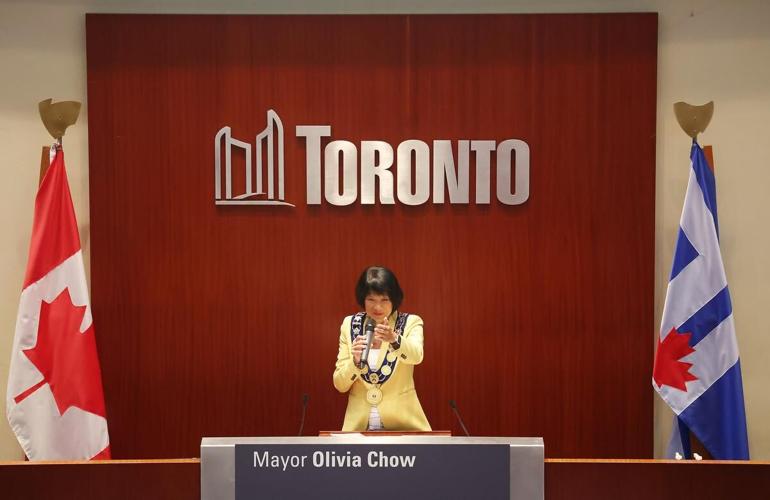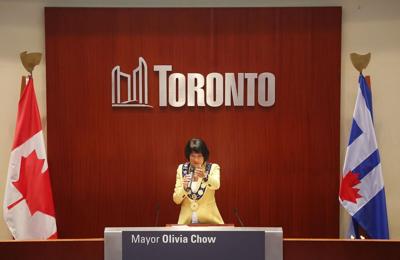Olivia Chow will officially become Torontoâs new mayor on Wednesday when sheâs formally sworn in. Although sheâs new to that position, itâs not the first time that sheâs been welcomed to council chambers.
Chow was first elected to what was then called Metro Council in November 1991, at the tender age of 34, after serving as a school board trustee.
âThe Addams Familyâ and âMy Girlâ were playing at the box office, Brian Mulroney was prime minister, and if you wanted to reach someone you had to call them on a landline.
But there are a surprising number of similarities as far as the city of Toronto, and council are concerned. A look at whatâs changed â and whatâs stayed the same â since Chow was first sat in council more than 30 years ago:
Transit woes
A string of acts of random violence on the TTC has left many riders on edge, while ridership is still only about 75 per cent of what it was before the pandemic, with the lost revenue from the fare box leaving a gap in the city budget. Riders are paying more for less frequent, more crowded service.
But it may be some comfort to know that things were not much rosier when Chow first became a councillor.
The TTC was losing riders, the Starâs Royson James wrote at the time, and âfalling behind in the race to make public transit more attractive than the automobile.â Higher fares were unpopular, but the only option, some politicians argued. They increased from $1.30 to $2 a ride in January 1992, Bruce DeMara reported, after a $31-million cut that eliminated an express bus route and stopped all-night service on three routes.
Budget battle blues
Chow is walking into a very challenging budget environment, with the city facing a $1.5-billion shortfall for 2022 and 2023.
Pandemic aid from other levels of government has been cut off, TTC revenue is down and the shelter system is swamped. Property tax increases have been kept at or below the rate of inflation for several years. City services, sometimes for things as simple as picking up dead raccoons in a timely manner, have suffered, and Chow will face some tough choices about how to avoid more cuts.
But itâs not the first time the outlook has been gloomy. As the Star reported in late 1991, the year ahead was expected to be âhorrendously difficult,â by Metro Chairman Alan Tonks. To keep tax increases at or below inflation, many of the preamalgamation municipalities, including Toronto, had drawn heavily from reserve funds, and revenue from building permits, interest payments and tax assessments was down.
Unlike now, the country was also in the grips of a bleak recession, with high unemployment.

Olivia Chow in 1992
Weil, BernardHousing highs and lows
for a ēŖŊĮÉįĮøšŲÍøone bedroom is more than $2,500 a month, according to , and the average price of a detached home almost $1.8 million, according to the (TRREB), costs which increasing interest rates have done little to ease. The housing crisis is one of the biggest challenges that Chow will have to tackle as mayor.
In 1991, the average price reported by TRREB was about $234,000, which to many current aspiring buyers, even accounting for inflation, sounds like a dream. But for homeowners at the time it was a disaster: during the recession of the early 1990s housing prices .
Rates may seem high now, pushing the cost of mortgages sky high, but , the prime rate was a whopping 9.94 per cent in 1991, and 7.48 per cent in 1992.
Corralling council
Although Chow made strides in some of the preamalgamation areas, particularly Scarborough, she still faces challenges getting a council divided among suburban-urban, and right-left lines.
In 1991-92, then-mayor June Rowlands, only had old city of ēŖŊĮÉįĮøšŲÍøneighbourhoods to deal with as there was no mega city yet, but there tough battles over taxes, cuts to services, and the police budget.
Clearing the air
Chow will inherit a city thatâs still reeling from a global pandemic â and dealing with the new threat of wildfire smoke.
In January 1992, the city was grappling with a different version of a similar health hazard. That month, a then-controversial new bylaw went into effect that increased non-smoking sections in restaurants from 30 per cent of seating capacity to half, the Star reported at the time. It was part of a new city campaign against second-hand smoke, to the chagrin of some owners.
Tourist troubles
While it may not be a top priority, the ēŖŊĮÉįĮøšŲÍøof today is reeling from the lost tourism dollars during the height of the pandemic. The Ontario Chamber of Commerce and the industry predict that the province will not recover completely until 2025.
It could be worse though. The Star reported that 1990 was a âterribleâ year for tourism, with 14.9 million visitors down from 17.2 million in 1989. And 1992 was not expected to be any better with no citywide conventions planned. The decline was blamed on the recession and ēŖŊĮÉįĮøšŲÍøbeing âexpensive.â





























To join the conversation set a first and last name in your user profile.
Sign in or register for free to join the Conversation